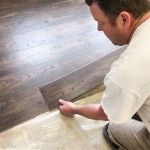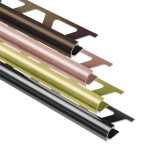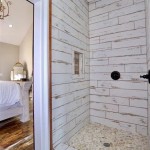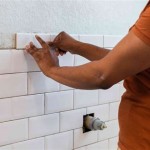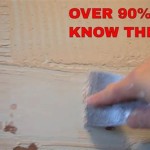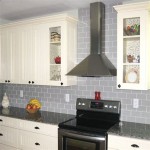Adding A Touch of Style To Your Home With White Wavy Tiles
White wavy tiles are emerging as a popular choice for homeowners and interior designers seeking to introduce texture and subtle visual interest to their spaces. These tiles, characterized by their undulating surface, offer a dynamic alternative to flat, uniform tiles, adding depth and personality to walls and backsplashes. Their versatility allows them to complement a wide range of design styles, from minimalist modern to coastal chic.
The allure of white wavy tiles lies in their ability to reflect light in a unique way. The textured surface scatters light, creating subtle shadows and highlights that continuously shift as the ambient light changes throughout the day. This dynamic interplay of light and shadow adds a sense of movement and visual richness to the space, preventing it from feeling sterile or monotonous. The white color further amplifies this effect, maximizing the reflection of light and making rooms appear brighter and more spacious.
Beyond their aesthetic appeal, white wavy tiles offer practical benefits. They are typically made from durable materials like ceramic or porcelain, ensuring longevity and resistance to wear and tear. Their smooth, glazed surfaces are easy to clean and maintain, making them a practical choice for high-traffic areas like kitchens and bathrooms. The textured surface can also provide a slightly increased grip, making them a safer option for wet areas.
Versatility in Design Applications
One of the primary reasons for the growing popularity of white wavy tiles is their remarkable versatility. They can be incorporated into a variety of design schemes, seamlessly blending with different architectural styles and color palettes. In modern minimalist spaces, they add a subtle layer of texture that prevents the design from feeling too stark or impersonal. The clean lines and simplicity of the tile complement the overall aesthetic, enhancing the sense of calm and tranquility.
In coastal-themed interiors, white wavy tiles evoke the feeling of rippling water or sand dunes, contributing to a relaxed and beachy atmosphere. When paired with natural materials like wood and rattan, they create a cohesive and inviting space that feels both stylish and comfortable. The undulating surface of the tiles can also mimic the movement of waves, further enhancing the coastal theme.
For more traditional or transitional designs, white wavy tiles can add a touch of contemporary flair without clashing with the overall aesthetic. They can be used as a backsplash in a kitchen with classic cabinetry or as an accent wall in a bathroom with vintage fixtures. The neutral color and subtle texture of the tiles allow them to integrate seamlessly into these designs, adding a touch of sophistication and visual interest.
The size and shape of the tiles also contribute to their versatility. White wavy tiles are available in a variety of sizes, from small mosaics to large format tiles. Smaller tiles can be used to create intricate patterns and textures, while larger tiles offer a more streamlined and modern look. The shape of the tiles can also vary, with rectangular, square, and even hexagonal options available. This allows homeowners and designers to choose the perfect tile to suit their specific needs and preferences.
Furthermore, white wavy tiles can be used in a variety of applications throughout the home. They are commonly used as backsplashes in kitchens and bathrooms, adding a touch of style and texture to these functional spaces. They can also be used as accent walls in living rooms, bedrooms, and hallways, creating a focal point that draws the eye and adds visual interest. In some cases, white wavy tiles can even be used as flooring, although this is less common due to the potential for uneven surfaces. The textured surface of the tiles can provide a unique and interesting flooring option, but it is important to consider the practical implications before making this choice.
Creating Visual Impact Through Placement and Grout
The visual impact of white wavy tiles extends beyond the inherent qualities of the tile itself. The way these tiles are placed and the choice of grout color can significantly influence the overall aesthetic of the space. Strategic placement can accentuate the texture and movement of the tiles, while the right grout color can either highlight or blend in with the tile, creating different visual effects.
There are several common placement patterns that can be used with white wavy tiles. A standard horizontal layout is a classic choice that creates a clean and simple look. A vertical layout can elongate the space, making it feel taller. A staggered layout, similar to a brick pattern, can add a touch of visual interest and movement. Herringbone and chevron patterns are more complex options that can create a dramatic and eye-catching effect. The choice of placement pattern depends on the desired aesthetic and the specific characteristics of the space.
The grout color plays a crucial role in defining the look of the tiled surface. A light-colored grout, such as white or light gray, will blend in with the tiles, creating a seamless and uniform appearance. This option is ideal for achieving a minimalist and modern look, as it emphasizes the subtle texture of the waves without drawing attention to the grout lines. A darker grout color, such as black or dark gray, will create a more contrasting and defined look. This option highlights the shape of the tiles and adds a touch of drama to the space. The choice of grout color should be carefully considered to ensure that it complements the overall design scheme.
In addition to placement and grout, the lighting in the room can also affect the visual impact of white wavy tiles. As mentioned earlier, the textured surface of the tiles scatters light, creating subtle shadows and highlights. By strategically placing lighting fixtures, it is possible to accentuate these effects and create a more dynamic and visually interesting space. For example, spotlights can be used to highlight the texture of the tiles, while ambient lighting can create a softer and more diffused effect.
The surrounding decor also plays a significant role in complementing the white wavy tiles. Natural materials like wood, stone, and linen can enhance the texture and warmth of the tiles, creating a more inviting and comfortable space. Metallic accents, such as brass or copper, can add a touch of sophistication and glamour. The color palette should be carefully considered to ensure that it harmonizes with the white tiles. Neutral colors, such as gray, beige, and white, create a clean and sophisticated look, while bolder colors, such as blue, green, and yellow, can add a touch of personality and vibrancy.
Maintaining the Beauty of White Wavy Tiles
While white wavy tiles are relatively easy to maintain, proper care and cleaning are essential for preserving their beauty and longevity. Regular cleaning will prevent the build-up of dirt, grime, and mildew, ensuring that the tiles continue to look their best for years to come. Choosing the right cleaning products and techniques is crucial to avoid damaging the surface of the tiles.
For general cleaning, a mild detergent and warm water are usually sufficient. Avoid using abrasive cleaners or scouring pads, as these can scratch the surface of the tiles and dull their shine. A soft cloth or sponge should be used to wipe down the tiles, paying particular attention to the grout lines. After cleaning, rinse the tiles thoroughly with clean water and dry them with a clean cloth to prevent water spots.
For more stubborn stains, a specialized tile cleaner may be necessary. However, it is important to choose a cleaner that is specifically designed for use on ceramic or porcelain tiles. Always test the cleaner on a small, inconspicuous area of the tile before applying it to the entire surface. This will ensure that the cleaner does not damage or discolor the tiles.
Grout lines are particularly susceptible to staining and discoloration. To clean grout lines, a grout brush and a grout cleaner can be used. Apply the grout cleaner to the grout lines and let it sit for a few minutes before scrubbing with the grout brush. Rinse the grout lines thoroughly with clean water and dry them with a clean cloth. For particularly stubborn stains, a mixture of baking soda and water can be used as a natural grout cleaner.
To prevent the build-up of mildew in wet areas like bathrooms, it is important to ensure proper ventilation. After showering or bathing, open a window or turn on the exhaust fan to remove excess moisture from the air. This will help to prevent the growth of mildew and keep the tiles looking clean and fresh. Sealing the grout lines can also help to prevent the absorption of moisture and stains.
By following these simple maintenance tips, homeowners can ensure that their white wavy tiles continue to add a touch of style and elegance to their homes for years to come. The combination of aesthetic appeal, practical benefits, and ease of maintenance make white wavy tiles a compelling choice for any interior design project.

Touch White Wave Matt Discount Tile And Bathroom Warehouse Gravesend

Msi Dymo Wavy White Ceramic Tile

Add Flare To A Room With These Textured Tile Collections Town News

18 Stylish Shower Tile Ideas Designs In 2024 Foyr

Msi Dymo Wavy White Ceramic Tile

10 Best Bathroom Tiles Design Ideas For Your Home

12 X 24 Light Gray Matte Porcelain Tile For Shower Bathroom Kitchen Backsplash Fireplaces And More Apollo

Vertical Shower Tile Ideas You Must Consider In 2024 Oasis

Idole Tear White Ceramic Tile Tiles Wall

Style And Decorate With Magnolia Tile Collection
Related Posts

